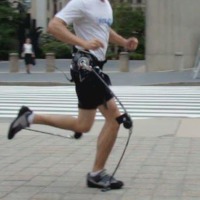This has been made possible with new
3D copying software developed by
Autodesk, that make producing custom limbs not only possible, but lighter, with a better fit and at a dramatically lower cost than traditional fabrication. The cost is so reduced that a wardrobe of legs for different moods and occasions is possible. Scanning technology allows for an exact map of the unique contours of the existing limb so that the body is perfectly naturally balanced with the remaining natural body. After, it’s about collaborating to find a design that will feel authentic to the person that will be taking it on as a new part of their body. So- feminine and lacy, conservative herringbone, incorporating existing tattoos, made of chrome or leather, even appropriately sporting a recycling symbol- each is a unique personal expression of the person wearing it. Some designs feature leather panels that can be changed out for a variety of looks.

There are 1.5 million amputees in the United States alone, so the market is already not inconsiderable. There are also bionic prostheses for able-bodied people being thrown into the mix.
Hugh Herr, a double amputee, MIT professor and the founder of his own company,
iWalk, has developed an
exoskeleton that allows runners to run on hard surfaces without knee and hip damage, and a bionic
exoskeleton that makes running take the same effort as walking giving us all the ability to have superpower like abilities, is being proto-typed now for release soon.
With able-bodied people wearing external prostheses added to the total potential market, it's easy to understand the eagerness to establish presence in this area now, and how prostheses will naturally be eventually perceived as just another new sportswear segment
 |
| Testing the new exoskeleton prototype in the lab |
It's no surprise, then, that existing big players in running equipment are already getting into the market.
Colin Matsco of New Balance designed the
Nike Prosthetic, a sports-branded leg specifically designed for a young, physically active, urban male market segment. It seems only a matter of time until wearing specific designer name limbs becomes a statement of status and lifestyle like any other sportswear or fashion choice.
.jpg) |
| Three views of sporty Nike Prosthetic |
As prosthesis become more attractive and responsive, there may be eventually be movement towards voluntarily "upgrading" existing body parts as we age and they cease to work effectively. Recently, 26 year old Patrick who waited for three years before finally opting to amputate his hand, that had been injured and was ineffective, for the greater mobility offerred by a
thought-controlled bionic hand . He says ""I think it was very cool - I did not do things with my hand for three years and then you put on the new hand and one moment later, you can move it. It's great." Although Patrick's hand is more utilitarian than sleek in design, the technology it represents will likely soon become the new accepted standard at which point aesthetics can take precedence.
When both the style and function ends of the equation are fully addressed, and we reach a future where no longer any social stigma attached to prosthesis, one can imagine rather different views of what is currently considered a viable medical option.
Perhaps the choice will between, say, implanting an artificial knee for a temporary fix and limited mobility in an aged limb will someday be weighed against amputation and attaching a completely new limb for a permanent and upgradable solution.
Far from the bionic super-hero one pictures, the old-age homes of the future may become the true new growth centers for bionic limb replacements, where robotic parts may be a normal option that may be considered in order to offer a resulting greater quality of life for aging men and women as their biological bodies start to break down.
 |
| Black quilted leather leg based on client's classic Channel purse |
"We want the bionic limb to have a humanlike shape but we don't want the bionic leg to look human. We want it to look like a beautiful machine, to express machine beauty as opposed to human beauty — and the reason is, we want the user to pull a black sock over their bionic limb and have their limb appear to be fully biological and then the very next evening, go to a fancy party where they pull that sock off and they expose the fact that part of their body is bionic." -Hugh Herr



.jpg)




No comments:
Post a Comment